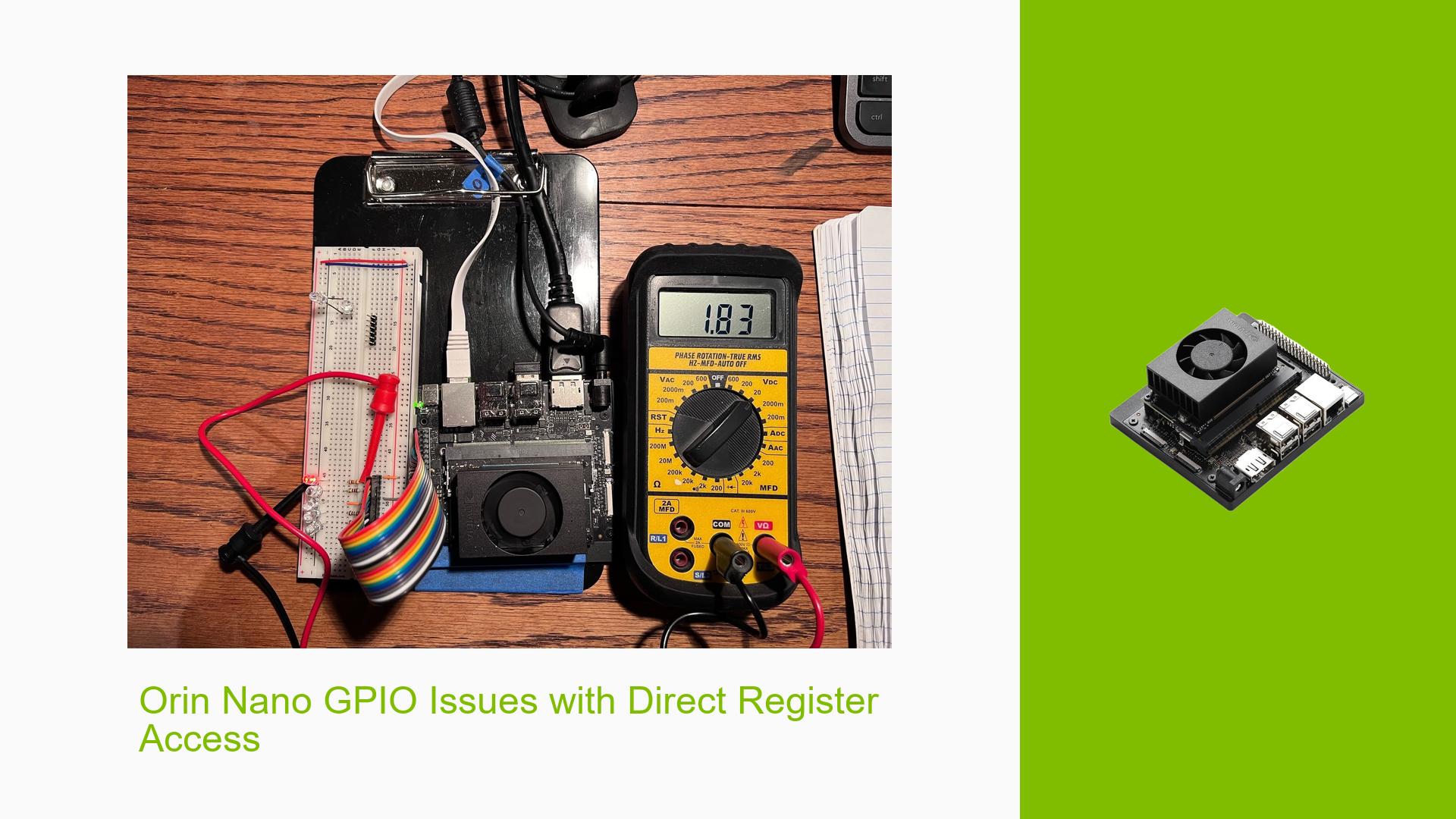Orin Nano GPIO Issues with Direct Register Access
Issue Overview
Users of the Nvidia Jetson Orin Nano Developer Kit have reported challenges when attempting to utilize General Purpose Input/Output (GPIO) pins for their projects, particularly when implementing direct register access (DRA) in C/C++. The primary symptoms include:
- Difficulty in identifying the official or recommended GPIO library for C/C++ that supports DRA, as previous libraries have become outdated or insufficient.
- Users have expressed concerns about potential damage to their developer kits due to improper library usage.
- Reports of GPIO output voltage levels being lower than expected (1.8V instead of the anticipated 3.3V), particularly when loaded with components like LEDs and resistors.
- Confusion regarding whether the GPIO pins on the Orin Nano are indeed configured to output at 3.3V, as some users observed voltage drops under load.
The issue predominantly arises during setup and initial testing phases while running applications that require precise GPIO control. The context is further complicated by the removal of sysfs support in JetPack 6.0, prompting users to seek alternatives for GPIO manipulation.
Possible Causes
Several potential causes have been identified for the issues experienced by users:
-
Hardware Incompatibilities or Defects: Users may be using non-official or defective developer kits that do not adhere to standard specifications.
-
Software Bugs or Conflicts: The transition from sysfs to the GPIO Character Device Userspace API may introduce bugs or compatibility issues with existing libraries.
-
Configuration Errors: Incorrect pinmux settings could lead to improper GPIO functionality, including incorrect voltage levels.
-
Driver Issues: Outdated or incorrect drivers may hinder proper communication with GPIO hardware.
-
Environmental Factors: External loads (like LEDs and resistors) could affect voltage levels, leading to discrepancies in expected behavior.
-
User Errors or Misconfigurations: Misunderstanding of pin configurations or library functions can lead to improper usage and unexpected results.
Troubleshooting Steps, Solutions & Fixes
To address the issues related to GPIO on the Nvidia Jetson Orin Nano Developer Kit, users can follow these troubleshooting steps and solutions:
-
Verify Library Usage:
- Use the GPIO Character Device Userspace API as recommended in JetPack 6.0.
- Confirm that you are utilizing a library that supports DRA effectively; libraries by Rubberazer have been positively reviewed by users.
-
Check Pinmux Configuration:
- Ensure that the pinmux settings are correctly configured for GPIO usage before attempting to access any pins.
- Reference the pinmux spreadsheet for details on which pins are configured for 1.8V and 3.3V operation.
-
Measure Voltage Levels:
- Disconnect any external loads (e.g., LEDs, resistors) and directly measure the voltage at the GPIO pins.
- If a pin measures 3.3V without a load but drops to 1.8V under load, it indicates a potential issue with the level shifter or configuration.
-
Testing Different Libraries:
- Experiment with various libraries if one does not meet your needs; user feedback indicates that Rubberazer’s library is straightforward and effective.
-
Use Level Shifters if Necessary:
- If interfacing with devices operating at different voltage levels (e.g., Teensy 4.0), consider using level shifters to ensure compatibility without signal degradation.
-
Documentation Review:
- Consult the latest documentation for the Orin Nano, including carrier board specifications and application notes, to ensure compliance with current standards.
- For comprehensive resources, refer to Nvidia’s dedicated documentation page for the Orin Nano development kit.
-
Monitor UART Communication:
- For UART-related projects, users have reported successful data streaming even with lower voltage outputs; ensure proper connections are made when testing UART functionality.
-
Community Engagement:
- Engage with community forums for support and shared experiences; many users have resolved similar issues through collaborative troubleshooting.
By following these steps, users should be able to diagnose and resolve issues related to GPIO functionality on their Nvidia Jetson Orin Nano Developer Kit effectively.
